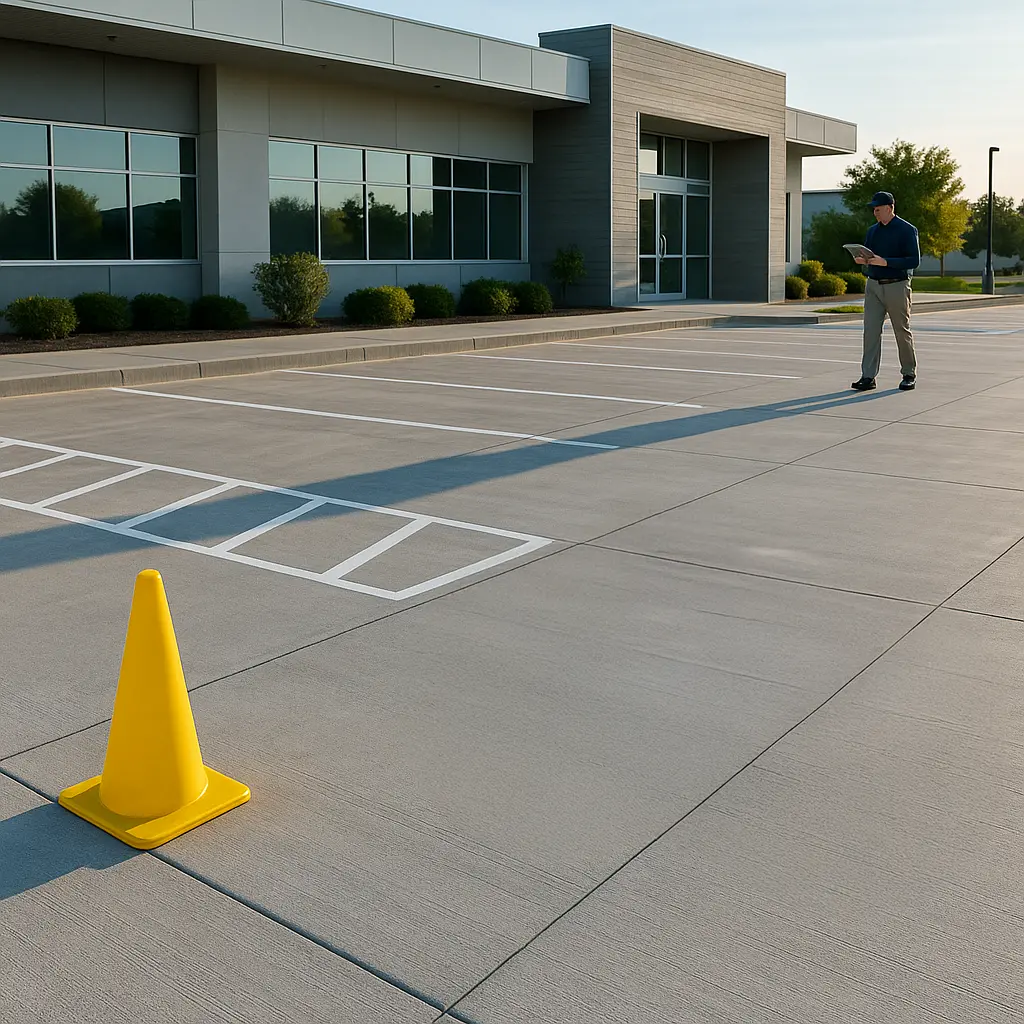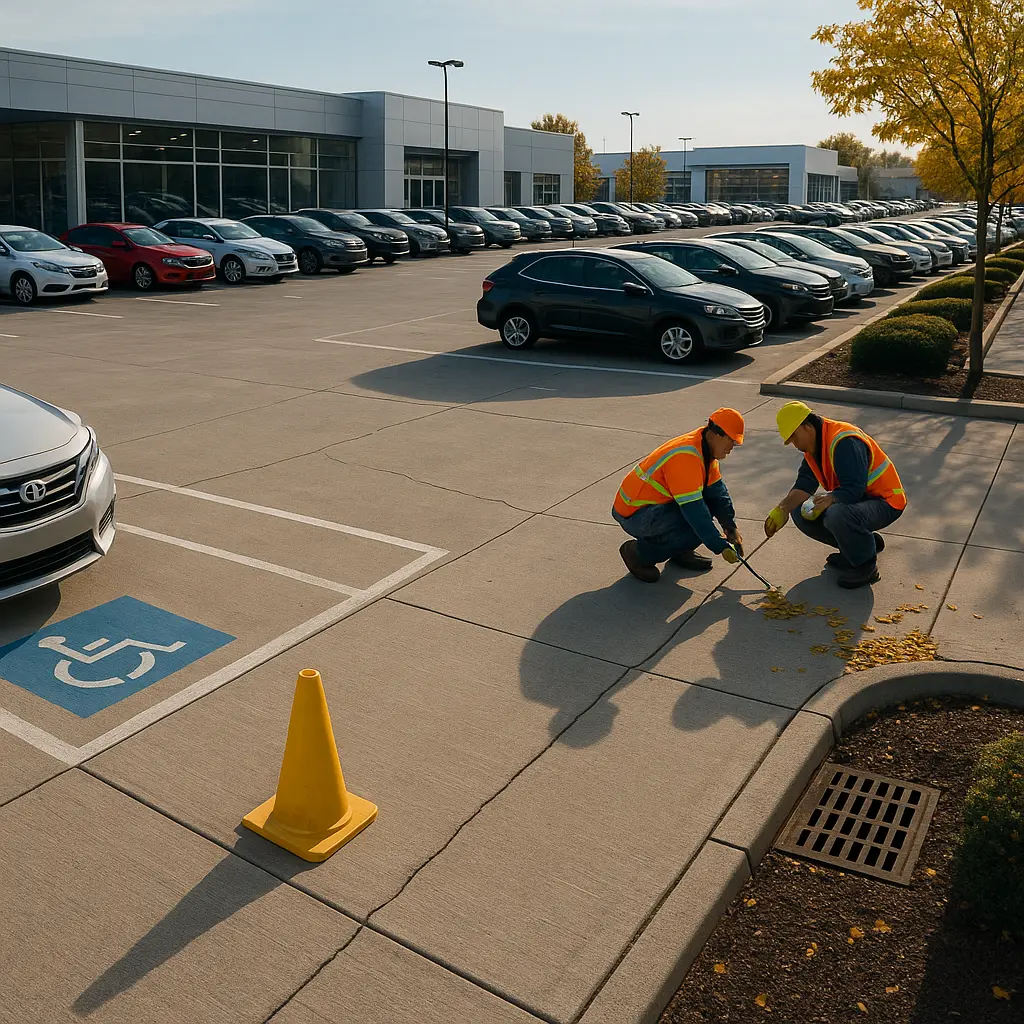 Your parking lot is one of the first things customers notice when they arrive at your business. Whether you manage a car dealership or a retail property, a well-maintained concrete lot creates a strong first impression and supports overall safety, accessibility, and ADA compliance in 2025.
Your parking lot is one of the first things customers notice when they arrive at your business. Whether you manage a car dealership or a retail property, a well-maintained concrete lot creates a strong first impression and supports overall safety, accessibility, and ADA compliance in 2025.
Like any part of your property, concrete surfaces deteriorate over time. Cracks, uneven slabs, and surface damage often develop gradually—but when left unchecked, they can become safety hazards and lead to costly repairs.
The good news is that most major issues are preventable with consistent upkeep. Below are practical tips to help you care for your parking lot throughout the year. These steps can extend the life of your concrete, reduce liability risks, and keep your business looking its best.
Download the 2025 Parking Lot Maintenance Checklist (PDF)
Common Issues in Commercial Concrete Parking Lots
Concrete parking lots are designed to handle vehicle traffic, but over time, even high-quality construction can show signs of wear. Early detection helps prevent serious and expensive repairs. Watch for these common issues:
- Cracks and Joint Separation
Often caused by temperature swings, soil shifting, or heavy loads. Water intrusion accelerates damage, especially in freeze-thaw conditions. - Surface Spalling and Scaling
This occurs when the surface flakes or chips away due to salt, freeze-thaw cycles, or improper finishing. Scaling reduces durability and aesthetics. - Water Pooling and Drainage Issues
Standing water is a red flag for drainage problems. It can cause slab erosion or settlement underneath the concrete. - Faded or Damaged Striping
Dull or missing paint on parking lines or ADA symbols can cause confusion or non-compliance with 2025 accessibility standards. - Slab Settling or Heaving
Changes in grade often stem from poor compaction, shifting soil, or root intrusion, leading to trip hazards and improper drainage. - Stains from Oil, Rust, or Chemicals
Chemical and oil stains can break down the concrete surface. Clean them early using pH-neutral concrete-safe cleaners.
Weekly & Monthly Visual Inspections
Walk your lot weekly or monthly to catch minor damage before it becomes a major problem. Use your checklist or log to note changes and plan repairs. Have inspection questions?
- New or Expanding Cracks
Monitor for changes. Prompt crack sealing prevents water intrusion and long-term damage. - Trip Hazards
Look for height differences between slabs. ADA compliance requires safe pedestrian access routes. - Water Pooling or Drain Blockages
Check all drains after storms to ensure water isn’t collecting. Clear debris from inlets to prevent flooding. - Curbing and Wheel Stop Damage
Replace broken pieces promptly to avoid tire damage or pedestrian trips. - Fading Striping and Signage
Keep directional markings, fire lanes, and ADA spaces clearly visible to stay code-compliant. - Oil, Rust, or Chemical Stains
Clean spills using concrete-safe degreasers to prevent long-term surface degradation.
Pro Tip: Photos taken during each inspection help document trends and may support warranty claims or vendor discussions.
Seasonal Maintenance Tasks
 Each season brings different environmental challenges. Here’s what to focus on:
Each season brings different environmental challenges. Here’s what to focus on:
- Spring
- Remove winter debris and clean salt residue
- Inspect for cracks or scaling from freeze-thaw damage
- Ensure all drainage systems are working
- Summer
- Pressure wash to remove oil and dirt buildup
- Seal cracks and joints
- Re-stripe parking lines and ADA spaces
- Fall
- Clean out storm drains and gutters
- Seal open joints before cold weather sets in
- Remove leaf buildup to avoid surface staining
- Winter
- Use non-corrosive deicers rated for concrete
- Avoid metal snow blades that chip the surface
- Limit heavy truck traffic on weak spots
Tip: Plan snow removal contracts early and confirm equipment will not damage curbs or pavement edges.
Best Practices for Long-Term Durability
- Seal Every 2–3 Years
Apply concrete sealer regularly to protect from moisture and UV damage. - Keep Striping Fresh
ADA guidelines require visible markings. Re-stripe before they fade too much. - Improve Drainage
If pooling persists, consider grading changes or adding trench drains. - Protect High-Stress Areas
Limit heavy truck traffic on thinner concrete sections. Reinforce where needed. - Use the Right Cleaners
Avoid acidic or solvent-based cleaners unless recommended by a professional. - Maintain Landscaping
Roots and overgrowth near curbs cause structural issues. Trim regularly.
When to Call a Concrete Repair Expert
Not every issue can be resolved through maintenance alone. Call in a professional when you observe:
- Recurring cracks in the same location
- Sunken or heaved slabs
- Persistent drainage problems
- Large areas of spalling or exposed rebar
- Broken expansion joints or missing joint sealant
Strengthening Technologies provides expert evaluation and repair services nationwide. We specialize in post-tension repair, epoxy injection, slab stabilization, and more—ensuring every concrete lot we restore is safe, durable, and ADA compliant.
Taking care of your parking lot doesn't require guesswork. With a clear checklist, consistent inspections, and trusted professionals available when needed, you can extend the life of your investment and protect everyone who visits your property.
